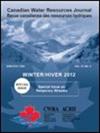使用年最大序列和峰值超阈值方法拟合洪水频率分布
IF 0.9
4区 环境科学与生态学
Q3 WATER RESOURCES
引用次数: 1
摘要
摘要洪水频率在水工建筑物设计以及渔业和水资源管理中起着重要作用。洪水频率分析有两种类型,即年最大序列(AMS)分析和部分持续时间序列分析(或超过阈值的峰值,POT)。POT分析包括研究高于特定阈值(或截断水平)的流量数据,而AMS方法使用最大年流量数据。AMS(广义极值-GEV分布)和POT(广义Pareto–GP和指数–Exp分布)均用于计算新不伦瑞克省米拉米奇河流域内四个水文站的洪水频率。提出了一种选择截断水位的简单方法,即每年对应1、1.5和2次洪水的值。在POT分析中考虑多个截断水平具有提供更多结果的优点,这些结果用于确定哪个水平提供了更好的洪水数据拟合。GEV(AMS)和GP(POT)分布最能代表Miramichi河内的洪水数据,而Exp(POT 年)。结果表明,对于POT方法,洪水计数为1时的截断水平(最高截断水平)通常更适合高重现期(>25)的洪水 年)。此外,较低的截断水平往往提供具有较小不确定性的洪水估计(较低的变异系数,如使用升降刀技术测试的)。最后,结果表明,AMS和POT方法在洪水频率分析中是互补的。AMS是更经典的洪水频率分析方法;然而,POT提供了更好的洪水特征(例如,震级、持续时间和洪水量)。本文章由计算机程序翻译,如有差异,请以英文原文为准。
Fitting flood frequency distributions using the annual maximum series and the peak over threshold approaches
Abstract Flood frequency plays an important role in the design of hydraulic structures as well as in the management of fisheries and aquatic resources. There are two types of flood frequency analyses, namely the annual maximum series (AMS) analysis and the partial duration series analysis (or peak over threshold, POT). The POT analysis consists of studying discharge data above a specific threshold (or truncation level), whereas the AMS method uses maximum annual discharge data. Both the AMS (generalized extreme value – GEV distribution) and POT (generalized Pareto – GP and exponential – Exp distributions) were used to calculate flood frequencies for four hydrometric stations within the Miramichi River basin of New Brunswick. A simple method was proposed for the selection of truncation levels, that is, values corresponding to 1, 1.5 and 2 flood counts per year. Considering multiple truncation levels in the POT analysis has the advantage of providing more results that are used to identify which level provides a better fit of the flood data. Both the GEV (AMS) and GP (POT) distributions best represented flood data within the Miramichi River whereas the Exp (POT) distribution did not fit well the data, especially for floods with high return periods (>25 years). Results showed the truncation level at a flood count of 1 (highest truncation level) for the POT method, generally provided a better fit of floods with high return periods (>25 years). Moreover, lower truncation levels tended to provide flood estimates with less uncertainties (lower coefficient of variation, as tested using a jackknife technique). Finally, results showed that both the AMS and POT methods are complementary in flood frequency analyses. The AMS is the more classic approach to flood frequency analyses; however, the POT provides a better characterization of floods (e.g. magnitude, duration and flood volume).
求助全文
通过发布文献求助,成功后即可免费获取论文全文。
去求助
来源期刊

Canadian Water Resources Journal
WATER RESOURCES-
CiteScore
2.90
自引率
5.90%
发文量
17
审稿时长
>12 weeks
期刊介绍:
The Canadian Water Resources Journal accepts manuscripts in English or French and publishes abstracts in both official languages. Preference is given to manuscripts focusing on science and policy aspects of Canadian water management. Specifically, manuscripts should stimulate public awareness and understanding of Canada''s water resources, encourage recognition of the high priority of water as a resource, and provide new or increased knowledge on some aspect of Canada''s water.
The Canadian Water Resources Journal was first published in the fall of 1976 and it has grown in stature to be recognized as a quality and important publication in the water resources field.
 求助内容:
求助内容: 应助结果提醒方式:
应助结果提醒方式:


